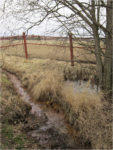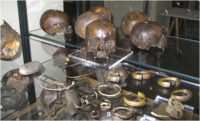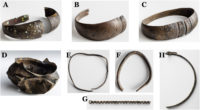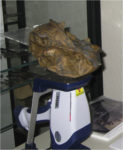Analysis of metal artifacts found at the Iron Age water burial site in Levänluhta, western Finland, has revealed links to an extensive exchange network stretching across Europe. This is the first-ever lead isotope analysis of copper artifacts found in Finland, and it sheds new light on the movement of materials through Europe in the Iron Age.
 With at least 98 individual burials (a DNA study published earlier this month found they were closely related to the current Sámi people, the first physical evidence of Sámi settlement in southern Finland), Levänluhta is the largest water cemetery in Finland. It’s also unusual in that most of the people buried there (there are animal bones among the assemblage as well) were women and children, and they were buried whole instead of being cremated which was the common burial practice in Finland at the time. There’s no evidence of human sacrifice on the remains, no sharp or blunt trauma, nor is there evidence on the bones that they died from illness or famine. The water cemetery was in use from 300-800 A.D. when it was a small pond; today it’s a wetland.
With at least 98 individual burials (a DNA study published earlier this month found they were closely related to the current Sámi people, the first physical evidence of Sámi settlement in southern Finland), Levänluhta is the largest water cemetery in Finland. It’s also unusual in that most of the people buried there (there are animal bones among the assemblage as well) were women and children, and they were buried whole instead of being cremated which was the common burial practice in Finland at the time. There’s no evidence of human sacrifice on the remains, no sharp or blunt trauma, nor is there evidence on the bones that they died from illness or famine. The water cemetery was in use from 300-800 A.D. when it was a small pond; today it’s a wetland.
 No pottery was found, but there were 22 metal objects buried with the remains. Most of them were jewelry — finger rings, arm rings, neck rings, brooches, a chain — plus a bronze cauldron and some metal rods of undetermined nature. They date to the Merovingian period (ca. 550–800 A.D.) and the design and decoration styles indicate they were created in local workshops in Finland, but Finland didn’t have native sources of copper during the Bronze and Iron Ages, and no evidence of metal workshops or even settlements has been found near the Levänluhta site. Until recently scholars believed the ore itself was imported from southern Sweden. However, studies in the past few years have found that the metal in Iron Age artifacts discovered in Sweden were also imported from elsewhere.
No pottery was found, but there were 22 metal objects buried with the remains. Most of them were jewelry — finger rings, arm rings, neck rings, brooches, a chain — plus a bronze cauldron and some metal rods of undetermined nature. They date to the Merovingian period (ca. 550–800 A.D.) and the design and decoration styles indicate they were created in local workshops in Finland, but Finland didn’t have native sources of copper during the Bronze and Iron Ages, and no evidence of metal workshops or even settlements has been found near the Levänluhta site. Until recently scholars believed the ore itself was imported from southern Sweden. However, studies in the past few years have found that the metal in Iron Age artifacts discovered in Sweden were also imported from elsewhere.
All 22 metal artifacts were recently analyzed using portable energy-dispersive X-ray fluorescence spectrometry (pXRF) analysis, a non-invasive technology that determines metal composition. They were found to be copper or copper alloys (bronze and brass).
 Eight of the pieces recovered from Levänluhta were analyzed using multi collector inductively coupled plasma mass spectrometry (MC-ICP-MS) to determine their lead isotope content. By comparing the lead isotope ratios in the artifacts to those found in domestic, Swedish and other European copper ores, scientists hoped to discover the origin of the raw material and trace their provenance.
Eight of the pieces recovered from Levänluhta were analyzed using multi collector inductively coupled plasma mass spectrometry (MC-ICP-MS) to determine their lead isotope content. By comparing the lead isotope ratios in the artifacts to those found in domestic, Swedish and other European copper ores, scientists hoped to discover the origin of the raw material and trace their provenance.
Based on typology, the oldest piece of the eight was a small arm-ring with a flattened end (ca. 100 A.D), followed by the Westland-type cauldron (300-575 A.D.) and the piece of chain (ca. 400 A.D.). The other five objects analyzed were arm rings and neck rings dating to the same late Iron Age (550-800 A.D.).
 MC-ICP-MS requires samples of the metal to work, so it is invasive, but researchers were able to make it minimally so drawing samples of just 7-10 mg. Because the samples were microdrilled from the artifacts, surface issues — wear, patina, corrosion — did not affect the results like they do pXRF analysis. The lead isotope and trace evidence found that the source of the copper ore was neither Finland, nor Sweden nor anywhere else in Scandinavia.
MC-ICP-MS requires samples of the metal to work, so it is invasive, but researchers were able to make it minimally so drawing samples of just 7-10 mg. Because the samples were microdrilled from the artifacts, surface issues — wear, patina, corrosion — did not affect the results like they do pXRF analysis. The lead isotope and trace evidence found that the source of the copper ore was neither Finland, nor Sweden nor anywhere else in Scandinavia.
Based on the lead isotope ratios, the copper in the objects has its origins in the copper ores found in Greece and Bulgaria. These regions produced a large quantity of copper in the Bronze and Iron Age, which spread around Europe as various object forms, distributed as presents, loot and merchandise. Metals were also recycled by melting old objects into raw material for new casts. It may be possible that metals that ended up in Finland during the Bronze Age were recycled in the Levänluhta region.
The findings of this project, funded by the Emil Aaltonen Foundation, demonstrate that products of the copper exchange network of continental Europe also reached Finland across the Baltic Sea, thus making it possible to link the region with the extensive copper exchange system known to have extended throughout Europe. The results also illustrate the temporally and technologically multi-layered nature of prehistoric metal artefacts: raw materials found their way here through a number of hands, most likely over a long period of time and across very great distances. In domestic artisan workshops, these metals of international origin were manufactured into pieces of jewellery in domestic Iron Age fashion, perhaps embodying the local identity and place of residence of the bearer.
The lead isotope study has been published in the Journal of Archaeological Science: Reports and can be read in its entirety online.